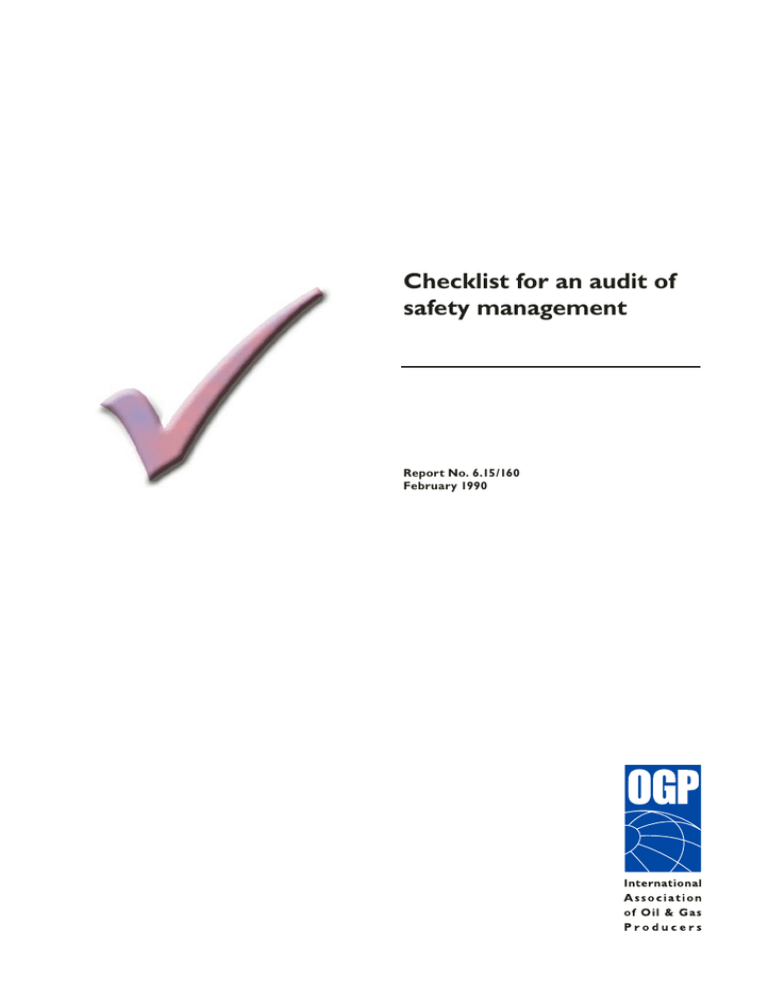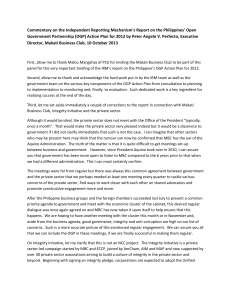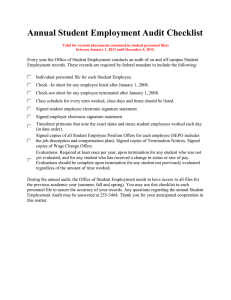
Checklist for an audit of
safety management
Report No. 6.15/160
February 1990
P
ublications
Global experience
The International Association of Oil & Gas Producers (formerly the E&P Forum) has
access to a wealth of technical knowledge and experience with its members operating
around the world in many different terrains. We collate and distil this valuable knowledge for the industry to use as guidelines for good practice by individual members.
Consistent high quality database and guidelines
Our overall aim is to ensure a consistent approach to training, management and best
practice throughout the world.
The oil and gas exploration and production industry recognises the need to develop
consistent databases and records in certain fields. The OGP’s members are encouraged
to use the guidelines as a starting point for their operations or to supplement their own
policies and regulations which may apply locally.
Internationally recognised source of industry information
Many of our guidelines have been recognised and used by international authorities and
safety and environmental bodies. Requests come from governments and non-government
organisations around the world as well as from non-member companies.
Disclaimer
Whilst every effort has been made to ensure the accuracy of the information contained in this publication, neither the OGP nor any of
its members past present or future warrants its accuracy or will, regardless of its or their negligence, assume liability for any foreseeable or
unforeseeable use made thereof, which liability is hereby excluded. Consequently, such use is at the recipient’s own risk on the basis that any
use by the recipient constitutes agreement to the terms of this disclaimer. The recipient is obliged to inform any subsequent recipient of such
terms.
Copyright OGP
All rights are reserved. Material may not be copied, reproduced, republished, downloaded, stored in any retrieval system, posted, broadcast
or transmitted in any form in any way or by any means except for your own personal non-commercial home use. Any other use requires the
prior written permission of the OGP.
These Terms and Conditions shall be governed by and construed in accordance with the laws of England and Wales. Disputes arising here
from shall be exclusively subject to the jurisdiction of the courts of England and Wales.
Checklist for an audit of safety management
Report No: 6.15/160
February 1990
Authors
This report has been prepared for OGP by their Committee on Safety Health and Personnel
Competence through its Safety Audit Work Group.
KMD Elliott, Exxon (Chairman); JA Doran, SIPM; I Wallace, Conoco; SW Barber, BP;
T Vere, Statoil; L Scataglini, Agip
Checklist for an audit of safety management
The purpose of auditing a safety management programme is to provide verified feedback to
management on the actual practices and equipment in an operation, taking care that the
areas sampled are meaningful.
The audit team should develop their own procedure/questions for implementing the audit.
Management will have in place systems to ensure conformance with legislative and regulatory requirements.
The checklist below identifies the main areas of a company’s safety management process
which auditors should review, as well as the minimum items which should be covered in
detail. It is important to comment on positive as well as non-conformance observations.
1 Demonstration of management commitment
• Safety Policy Statement is endorsed by Chief Executive of the Company. It is prominently
displayed at worksites and in company documentation, and is regularly discussed.
• Senior Management are visibly committed to safety. Check for:
– involvement in the appropriate company safety committees
– carrying out safety ‘walkabouts’ and site visits
– making personal statements on safety
– holding regular, routine safety performance reviews
– active involvement in incident reviews and follow-up (incidents include injuries,
emergencies and near misses)
– inclusion of safety as a high priority item during management and staff meetings
– appropriate resourcing is committed to safety.
• Senior management comparing safety performance on an inter and intra-company
basis.
• Management participation in setting safety standards and measurable targets, and in
establishing performance measurement systems and procedures.
• Management personally practising safety as a top priority and ensuring that their organisation does not compromise safety in pursuit of other goals.
• Management and supervision demonstrating a deep belief that safety is part of their job,
and behaving accordingly.
2
©2000 OGP
Checklist for an audit of safety management
2 Organisational and operational requirements
• Line management (including supervisors, foremen etc.) are clearly accountable for safe
operations.
• There are effective stewardship systems in place, e.g.:
– job descriptions specify safety responsibility,
– clear, safety objectives with measurable targets (not necessarily numerical),
– regular review of individual performance. Staff appraisals should include safety as a
performance criterion.
• Active and effective safety plans and programmes are in place.
• An accident reporting and classification system is in place which permits comparison of
safety performance on an inter and intra-company basis.
• There is an effective professional safety group with direct access to senior management.
The safety group is a mix of experienced safety professionals and operations and management staff.
• The safety department (group) acts effectively as a support to line management, not as
an alternative.
• Line management is accountable for the safety of contractors’ operations, has the necessary authority, and ensures that safety requirements specified in the contracts are met.
3 Personnel selection and training
• There is an established and effective procedure for defining individual employee qualifications for all positions and ensuring that appointments are made against these criteria.
• A structured approach has been used to identify all employee safety training needs.
• The system ensures that minimum training needs are satisfied before employees start or
change jobs.
• There is a system for follow-up on newly placed personnel to verify their adjustment of
the job. This follow-up should include a review of the need for changes to the employee
qualification criteria and/or personnel training.
• There is an effective safety training programme in place, covering all job positions which
is regularly reviewed and updated.
• There is a system to ensure that the training programme is implemented.
• There is a procedure for measuring training effectiveness.
©2000 OGP
3
• There is a system in place for identifying personal training needs following changes to
equipment, standards, procedures and specialised operations ensuring that training is
implemented in a timely manner.
• There is a system regularly validating the competence of the training instructors.
• Where on-the-job training is used, it is carried out in a consistent measurable, and structured way which ensures required standards are achieved.
• The training standards apply to both company employees and contractors.
• Training programmes make use of lessons learned and experience developed from previous incidents.
4 Engineering and operating standards
• There are clearly defined standards for engineering, maintenance, construction and
operations which are endorsed by management.
• Standards are regularly reviewed and updated as necessary.
• A system exists which ensures conformance with standards. The system should include
Risk Assessment/Hazard Analysis, and involve review by safety as well as engineering
and operations management.
• Conformance to Standards is monitored regularly.
• Contractor standards are checked and approved by the company.
• Key standards relevant to operations are available at worksites.
• There is an effective system for the management of modifications to equipment and
operational systems and procedures.
• Personal protective equipment requirements are identified and rigorously implemented.
• The Purchasing Control system ensures that equipment and materials are obtained
against approved standards.
• There are effective Quality Control and Quality Assurance systems operating.
4
©2000 OGP
Checklist for an audit of safety management
5 Operating and safety procedures
• There is a programme which systematically identifies which operations require written
procedures, and updates the list routinely.
• Written procedures exist for all identified routine operations which are:
– compatible with the design intent
– easily understandable and usable
– readily available at the site where the operation will take place
– regularly reviewed and updated, including consultation with the staff using the procedure
– verifiably followed.
• There is an effective system in place for the identification, development and approval of
procedures for non-routine operations.
• Safe working practices are:
– defined
– documented
– followed
– updated
These practices should cover all aspects of the operation, such as maintenance, inspection,
corrosion control, production operations etc.
• There are effective work control systems in place, e.g.:
– permit to work
– equipment inspection
– radiation monitoring
• Adequate records are readily available.
©2000 OGP
5
6 Emergency and incident response
• There are thorough and effective contingency plans.
• There is a documented emergency procedure, which is:
– well communicated and understood
– regularly tested in practice
– regularly updated
– easily understandable and usable.
• There is a clearly defined emergency response organisation:
– with well-understood individual responsibilities
– systems for modification
– training
– regular drills and exercises
– includes non-company agencies where appropriate.
• The lessons learned and experience gained from drills and exercises are widely communicated and reflected in future procedures and plans.
• There are emergency response control facilities which are:
– readily available
– tested regularly.
• There is a formalised incident investigation procedure which includes an analysis of the
incident, evaluation of the causes, communication of the lessons learned, and ensures
follow-up recommendations are implemented at a timely manner.
7 Audits and inspection
• There is a programme which provides regular objective feedback to management covering the full range of facilities and activities including:
– detailed engineering and operations reviews
– reviews of standards
– audits of conformance.
6
©2000 OGP
Checklist for an audit of safety management
• There is a system which ensures that recommendations are approved by management
and implemented according to an agreed timetable.
• The company audit and inspection programmes will likely include not only the corporately administered requirements but also local programmes which could include the
workforce as auditors.
• There is an inspection programme which gives management the opportunity to observe
the operation and conditions at work sites.
8 Motivation and communication
• There is a clearly defined and implemented communication structure which enables
open and frank two-way communication.
• There is clear communication of collective and individual safety performance.
• There is consultation and communication of safety objectives, tasks and targets.
• There is a programme recognising safety performance.
• There is a system in place for the reporting of hazards, follow-up by manager and feedback to the initiator.
• Regular meetings have defined purpose, structure and records.
• There are ad hoc meetings for special tasks/reviews.
• There is a system in place to encourage safety suggestions and ideas.
• There is an effective safety awareness programme which includes promotion, publicity,
off-the job safety etc.
©2000 OGP
7
9 Contractors
• Safety is an integral part of the contractor selection procedure.
• Contracts contain clear provisions requiring the contractor to meet safety conditions and
specifications consistent with the company’s standards for its own employees.
• There is an audit of contractor performance and facilities prior to the start up of work.
• There is a system for approving contractor working procedures for use on company
operations.
• There is a system for verification of contractors’ training programmes, individual
competence/qualifications, skill achievements, and where appropriate team experience.
• The contractor has to demonstrate:
– safety commitment from their senior management,
– clearly defined safety responsibilities,
– an active safety programme,
– a system for reporting safety performance and investigation of incidents,
– an effective communication and consultation system,
– an effective control of sub contractors.
• Company supervision monitors contractors’ performance.
6
©2000 OGP
What is OGP?
The International Association of Oil & Gas Producers encompasses the world’s leading private and stateowned oil & gas companies, their national and regional associations, and major upstream contractors and
suppliers.
Vision
• To work on behalf of all the world’s upstream companies to promote responsible and profitable
operations.
Mission
• To represent the interests of the upstream industry to international regulatory and legislative bodies.
• To achieve continuous improvement in safety, health and environmental performance and in the
engineering and operation of upstream ventures.
• To promote awareness of Corporate Social Responsibility issues within the industry and among
stakeholders.
Objectives
• To improve understanding of the upstream oil and gas industry, its achievements and challenges and its
views on pertinent issues.
• To encourage international regulators and other parties to take account of the industry’s views in
developing proposals that are effective and workable.
• To become a more visible, accessible and effective source of information about the global industry, both
externally and within member organisations.
• To develop and disseminate best practices in safety, health and environmental performance and the
engineering and operation of upstream ventures.
• To improve the collection, analysis and dissemination of safety, health and environmental performance
data.
• To provide a forum for sharing experience and debating emerging issues.
• To enhance the industry’s ability to influence by increasing the size and diversity of the membership.
• To liaise with other industry associations to ensure consistent and effective approaches to common
issues.
209-215 Blackfriars Road
London SE1 8NL
United Kingdom
Telephone: +44 (0)20 7633 0272
Fax: +44 (0)20 7633 2350
165 Bd du Souverain
4th Floor
B-1160 Brussels, Belgium
Telephone: +32 (0)2 566 9150
Fax: +32 (0)2 566 9159
Internet site: www.ogp.org.uk
e-mail: reception@ogp.org.uk




